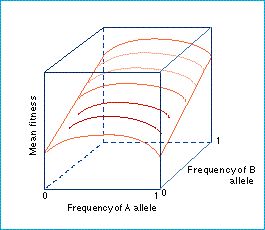Multi-locus population genetics - What is an adaptive topography?

Multi-dimensional fitness surfaces
Now consider a second locus. Selection can be going on here too, and the fitness surface for the two loci might look like the figure opposite. It shows a simple case in which one locus has heterozygous advantage and the other has a single favored allele. The idea of an adaptive topography can be extended to as many loci as interact to determine an organism's fitness, but the further loci have to be imagined, rather than drawn on two-dimensional paper.
Wright believed that, because the genes at different loci interact, a real multi-dimensional fitness surface would often have multiple peaks, with valleys between them
In the coadapted supergenes of Papilio memnon , the mimetic genotypes occupy fitness peaks and the recombinants occupy various fitness valleys. The actual shape of the adaptive topography in nature is, however, a more advanced question than can be tackled here. The point is that the visual simplicity of an adaptive landscape can be useful in thinking about evolution when many gene loci are interacting.
Figure: fitness surface for two loci. Heterozygous advantage at locus A and one allele has higher fitness than the allele at locus B.
| Next |



